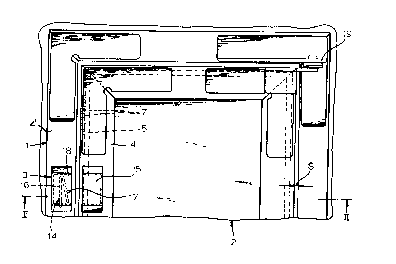Some of the information on this Web page has been provided by external sources. The Government of Canada is not responsible for the accuracy, reliability or currency of the information supplied by external sources. Users wishing to rely upon this information should consult directly with the source of the information. Content provided by external sources is not subject to official languages, privacy and accessibility requirements.
Any discrepancies in the text and image of the Claims and Abstract are due to differing posting times. Text of the Claims and Abstract are posted:
| (12) Patent: | (11) CA 2111666 |
|---|---|
| (54) English Title: | FIRECODE ACCESS PANEL |
| (54) French Title: | PANNEAU D'ACCES INCENDIE |
| Status: | Expired and beyond the Period of Reversal |
| (51) International Patent Classification (IPC): |
|
|---|---|
| (72) Inventors : |
|
| (73) Owners : |
|
| (71) Applicants : |
|
| (74) Agent: | BORDEN LADNER GERVAIS LLP |
| (74) Associate agent: | |
| (45) Issued: | 1997-11-25 |
| (22) Filed Date: | 1993-12-16 |
| (41) Open to Public Inspection: | 1994-07-01 |
| Examination requested: | 1994-05-06 |
| Availability of licence: | N/A |
| Dedicated to the Public: | N/A |
| (25) Language of filing: | English |
| Patent Cooperation Treaty (PCT): | No |
|---|
| (30) Application Priority Data: | ||||||
|---|---|---|---|---|---|---|
|
The panel assembly has a panel generally fitting in a hole and having an outer
periphery running generally parallel to the inner periphery of the hole. Respective
geometrically similar inner and outer annular frames on the inner and outer peripheries
have confronting outer faces forming an annular gap around the panel between the inner
and outer frames. One of the frames has an inner face forming an annular compartment
extending around the respective periphery. This one frame is formed with an array of
throughgoing openings which extend between the respective inner and outer faces and
connect the compartment with the gap. The compartment is substantially closed except
at the openings. An annular body of heat-swellable mate rial is provided in the
compartment so that on heating of the material it swells and exits the compartment
through the openings to fill the gap.
La présente invention vise un panneau constitué d'un élément inséré dans une ouverture et dont le bord extérieur est généralement parallèle au bord intérieur de l'ouverture. Le bord extérieur de l'élément et le bord intérieur de l'ouverture sont respectivement garnis d'un cadre de géométrie similaire, entre les faces externes desquels un vide annulaire est aménagé. La face interne de l'un des cadres forme un compartiment annulaire sur toute la périphérie. Ce cadre comporte un ensemble d'orifices qui en traversent les deux faces et relient le compartiment au vide annulaire. Mis à part les orifices, le compartiment est essentiellement fermé. Un cordon de matériau gonflable à la chaleur est inséré dans le compartiment; lorsque ce matériau est chauffé, il gonfle et se répand dans le vide annulaire par les orifices.
Note: Claims are shown in the official language in which they were submitted.
Note: Descriptions are shown in the official language in which they were submitted.

2024-08-01:As part of the Next Generation Patents (NGP) transition, the Canadian Patents Database (CPD) now contains a more detailed Event History, which replicates the Event Log of our new back-office solution.
Please note that "Inactive:" events refers to events no longer in use in our new back-office solution.
For a clearer understanding of the status of the application/patent presented on this page, the site Disclaimer , as well as the definitions for Patent , Event History , Maintenance Fee and Payment History should be consulted.
| Description | Date |
|---|---|
| Inactive: IPC from MCD | 2006-03-11 |
| Inactive: IPC from MCD | 2006-03-11 |
| Time Limit for Reversal Expired | 2004-12-16 |
| Letter Sent | 2003-12-16 |
| Inactive: Entity size changed | 2002-11-20 |
| Letter Sent | 2000-01-21 |
| Inactive: Office letter | 1999-09-08 |
| Inactive: Office letter | 1999-04-27 |
| Grant by Issuance | 1997-11-25 |
| Inactive: Adhoc Request Documented | 1997-09-19 |
| Inactive: Application prosecuted on TS as of Log entry date | 1997-09-19 |
| Inactive: Status info is complete as of Log entry date | 1997-09-19 |
| Pre-grant | 1997-07-08 |
| Pre-grant | 1997-07-08 |
| Pre-grant | 1997-07-08 |
| Notice of Allowance is Issued | 1997-04-22 |
| Application Published (Open to Public Inspection) | 1994-07-01 |
| All Requirements for Examination Determined Compliant | 1994-05-06 |
| Request for Examination Requirements Determined Compliant | 1994-05-06 |
There is no abandonment history.
| Fee Type | Anniversary Year | Due Date | Paid Date |
|---|---|---|---|
| Final fee - small | 1997-07-08 | ||
| MF (patent, 4th anniv.) - small | 1997-12-16 | 1997-12-04 | |
| MF (patent, 5th anniv.) - small | 1998-12-16 | 1998-10-21 | |
| Registration of a document | 1998-12-14 | ||
| MF (patent, 6th anniv.) - small | 1999-12-16 | 1999-11-22 | |
| MF (patent, 7th anniv.) - small | 2000-12-18 | 2000-08-29 | |
| MF (patent, 8th anniv.) - small | 2001-12-17 | 2001-06-28 | |
| MF (patent, 9th anniv.) - standard | 2002-12-16 | 2002-11-12 |
Note: Records showing the ownership history in alphabetical order.
| Current Owners on Record |
|---|
| OPUS PATENT-UND KNOW-HOW VERWERTUNGSGESELLSCHAFT MBH |
| Past Owners on Record |
|---|
| CHRISTOPH LANGENHORST |